A line of acacia trees is perfectly silhouetted against the orange-violet streak of the setting Kenyan sun. We’ve been on the hunt all day for lions on our first game drive through the Masai Mara, but the roars we hear as the sun drops do not belong to a big cat, but to the engine of our safari jeep.
The sky is darkening, an electrical storm is approaching, and we’re stuck in the mud in an area world famous for its large population of lions, leopards, cheetahs and buffalo.
Our group of six are under strict instructions to stay inside the truck – nature reserve rules – and feeling pretty powerless (not to mind weighty). We jerk around in the jolting vehicle as Joe and Joseph, our guide and driver, attempt to pull us out of the swampy hole.
Our pleas to help eventually conceded, we join Joe shin-deep in the inky black muck. We push. We heave. And several times we almost succeed in pushing the massive hunk of metal up over the ditch. After one particularly strenuous effort, a voice asks from the other side of the vehicle, “Guys, what’s that moving over there?”
All 800kg of this beast is standing so close we can almost hear him breathe, his curled horns piercing the dusky sky
We pile back onto the truck, and with our heads popped out the top, in the fading light we can just about make out the shadow of a buffalo shunting towards us. It’s the first we’ve seen all day, and he is giant. The ranger is radioed for help. All 800kg of this beast is standing so close we can almost hear him breathe, his curled horns piercing the dusky sky. Thankfully, he bores quickly, and turns away into the night.
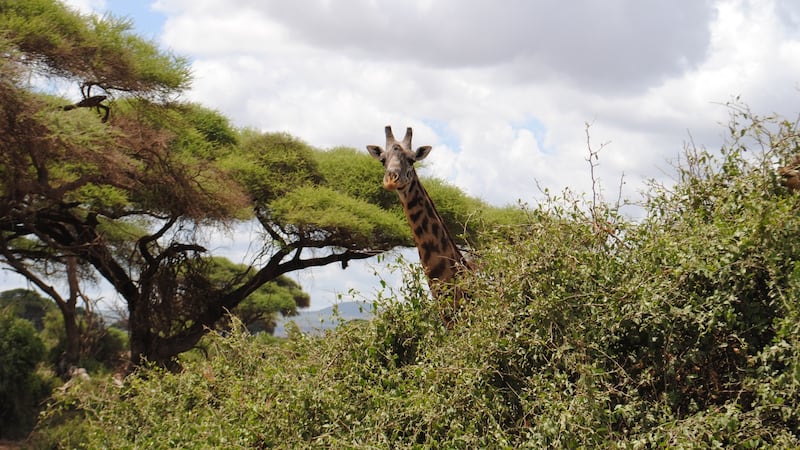
Huddle in darkness
As we huddle in the darkness wondering if we'll be spending our first night in Kenya sleeping in the safari truck with an eye half open for curious beasts, a light zips by in the distance. The ranger is on the way! Joe laughs uncontrollably. The glimmer we took for an oncoming vehicle is only a firefly.
Joseph tries a different tack with the revving and gear-changing, and after an almighty roar, the four-wheel drive engages and the truck shunts up and forward out of the murky depths. We’re free! But still a long drive from our lodgings, with only the headlights, the flash of fork lightning, and the gleaming eyes of nervous night creatures to guide us back.
The risk of getting stuck or lost may be high in the Masai Mara, but the lack of roads – along with the abundant wildlife of course – is what makes this national park stand out from others in Kenya.
Although the safari vehicles are not permitted to go completely off-road into the bush like they can in a private game reserve, the Mara is criss-crossed by tracks which allow the vehicles to get right up close to the wildlife. That freedom to take off in whatever direction takes the driver’s fancy, or to follow an animal spotted far off in the distance, is a real thrill. The vast open spaces also make it particularly easy to spot the big cats.
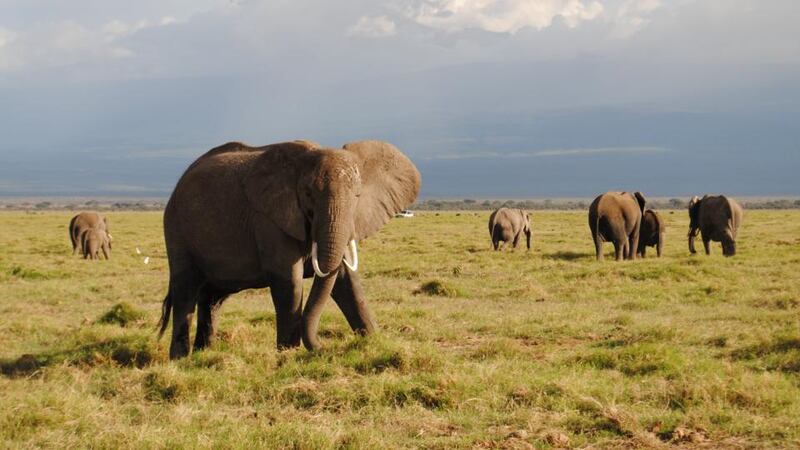
Before hitting that ditch, we had marvelled at a lone elderly bull elephant, a giraffe, and grazing herds of impalas, gazelles, topis and zebras. The highlight is finding two cheetah cubs with their mother Malaika, the reserve’s most famous cat, who is all over YouTube climbing on tourist vehicles to get a better view of potential prey. For most of us, it is our first day ever on safari and we’re delighted with our sightings, even if Malaika has kept her distance this time.
Coral pink ears
Crossing a bridge to leave the safari lodge the next morning, we spot the coral pink ears of a hippo twitching above the surface of the murky river below. It’s a taster of what we will see later at a watering hole; a huddle of hippos hiding from the heat of the day. As they can stay completely submerged for up to five minutes at a time, it is hard to count how many there are in total, but we guess about 40, of varying ages and sizes. Colossal heads rise for breath every now and then, before their giant masses burp back underwater.
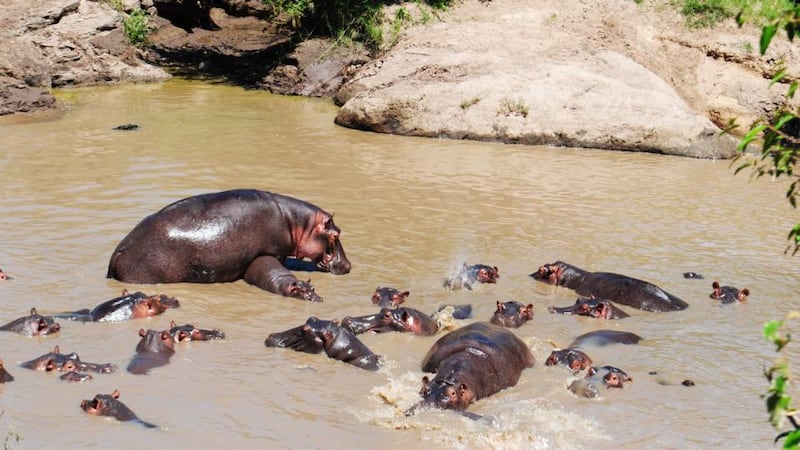
Day two makes an early win over day one when we pull up alongside a huddle of other jeeps as a leopard saunters casually by, the black of her spots shining in the morning sunlight. Even the two Joes are taken aback; leopards are notoriously private creatures and sightings of them are rare enough. Such a brazen walk-by in front of vehicles full of tourists, their cameras clicking furiously, is almost unheard of.
We later discover the reason for her nonchalance, when one of the group follows the #MasaMara hashtag on Instagram and finds a pic of the same leopard posted by a wildlife photographer an hour before we found her, a fresh kill hanging from her jaws. She was too full to care who was watching her.

Later in the afternoon, when the truck veers off the track and onto the grass for the first time in two days, we know the Joes have spotted something good. They speak in code and don’t tell us what they mean by “kala singha” (Swahili for “Indian moustache”, which we later learn is their code word for a male lion), until we pull up about 10 metres from a low bush, sheltering a lion with his huge black mane and two lionesses from the afternoon sun.
He gets up on top of her – rather reluctantly, we think – and within seconds it is all over and the three of them resume their sleeping positions
“Get ready for 10 seconds of action,” Joe chuckles, as the female closest to us grunts, rises, and paws at the male for attention. He gets up on top of her – rather reluctantly, we think – and Joe is right; within seconds it is all over and the three of them resume their sleeping positions. But the male is not permitted to rest for long; within minutes the lioness is wiggling her rear at him again. He’s more affectionate second time round, licking her around the ears before collapsing with a big roar.
Nine cubs
She looks satisfied but that might not last; when a female is in heat, she can mate up to 70 times a day. No wonder the male was slow to respond to her advances. Shortly afterwards, “kichwa mingi” (meaning “many heads” or a group of lions – we’re beginning to decipher their code), are spotted among lush grass in the distance, and we go to watch three lionesses and their nine cubs rolling and tumbling in the early evening sun.
The only other truck observing the action belongs to a group of filmmakers, who have sent a remote-control camera into the grasses for a close-up view. How special it is to witness in the flesh wildlife worthy of a documentary.
Spotting the filmmakers gets us talking about our most memorable David Attenborough scenes, and I mention mine: the vicious battle between two giraffes in the Namib desert, from his 2013 Africa series. Anyone who has seen it will remember the two otherwise elegant long necks ricocheting off one another, as a bull and younger calf fought for leadership of the herd. A short time after our conversation, in the distance we spot the tall X of two giraffes squaring up to each other in a vast open space, their necks craning and bending in preparation to strike similar blows.
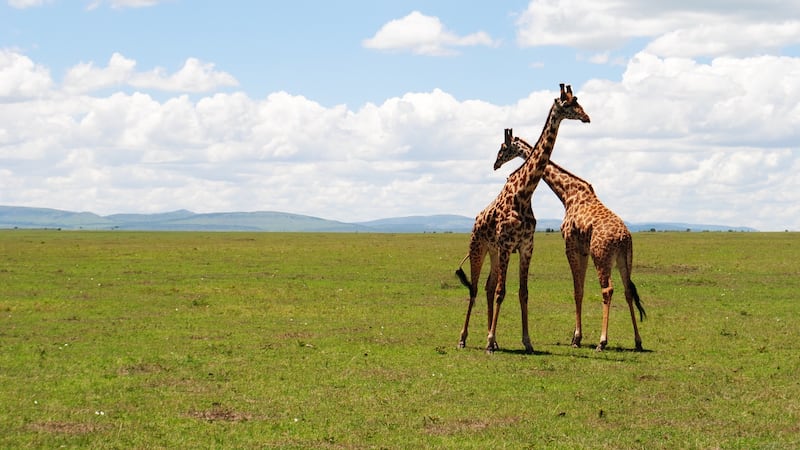
A long drive the next day takes us to Lake Nakuru, a soda lake in the Rift Valley about 1,700m above sea level. Having already seen elephants, buffalo, a leopard and lions in the Masai Mara, we're on the lookout for a rhino, the last of the "Big Five" to tick off our list. We're through the park gates no more than 15 minutes when Joe spots one through the fever trees near the water, binoculars revealing it is a mother with a calf bouncing along by her side.
Flamboyance of flamingos
The roadside posters for Nakuru invariably show the flocks of flamingos (collectively called a “flamboyance”, which is tickling), for which the reserve is famous. The pink birds lived here in their millions until the water level rose suddenly in 2013, destroying the algae for which they came. The bare trunks of dead trees a few metres into the water from the shoreline betray the devastating impact of climate change on this area. Most of the flamingos have since migrated to Lake Bogoria in search of food. We spot just a few dozen, a marshmallow pink smudge along the lakeshore.
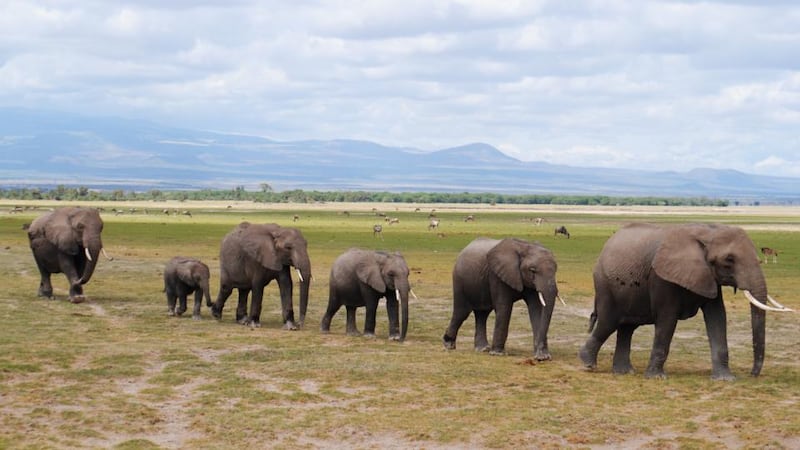
We’ve seen surprisingly few elephants by day five, but there is no better place to find them than in Amboseli National Park, the last stop on our Kenyan tour. With 1,500 elephants visiting the 391sq km park every day from the surrounding area, to play and feed and stay cool in the electric-green marshland, Amboseli is home to the highest concentration of elephants in the world.
Watching a long line of these beautiful animals – led by their matriarch and with a tiny baby just a few weeks old in tow – making their way home towards Mount Kilimanjaro, with the setting sun in the background, is the perfect closing scene.

















